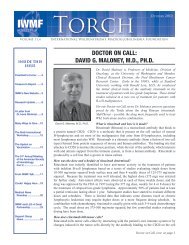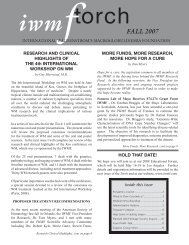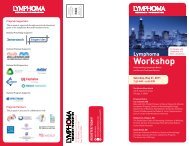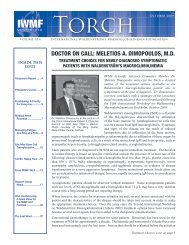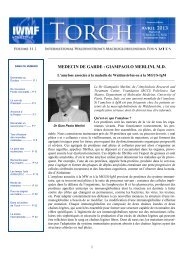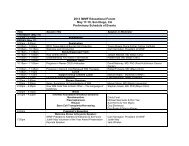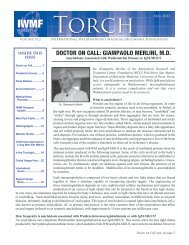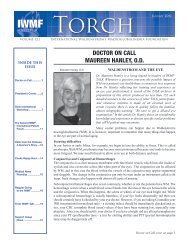English - International Waldenstrom's Macroglobulinemia Foundation
English - International Waldenstrom's Macroglobulinemia Foundation
English - International Waldenstrom's Macroglobulinemia Foundation
You also want an ePaper? Increase the reach of your titles
YUMPU automatically turns print PDFs into web optimized ePapers that Google loves.
Letter to the Editor, cont. from page 12<br />
The most critical site is involvement of the spine in<br />
which a tumor consisting of malignant lymphocytes and<br />
plasma cells compresses the spinal cord. The patient<br />
usually presents with back pain and may have numbness,<br />
tingling and weakness of the lower extremities as well<br />
as difficulties in bowel or bladder function. This is a<br />
“medical emergency” and the patient must have an MRI<br />
or a CT scan of the spine immediately to localize the<br />
tumor. Radiation therapy and dexamethasone are the<br />
usual therapy. I do not recommend routine MRI or CT<br />
scans of the spine of patients with WM, but if the patient<br />
has any symptoms suggesting the presence of a tumor<br />
compressing the cord, immediate evaluation is essential.<br />
As Mr. Altman pointed out, this can occur without any<br />
change in the M spike or IgM levels.<br />
Malignant lymphocytes and plasma cells may involve<br />
the lung and appear as an infiltrate or a mass on the<br />
chest x-ray. The pleura may also be infiltrated by<br />
malignant lymphocytes and plasma cells and produce<br />
pleural effusion (fluid around the lungs). In addition,<br />
the lymph nodes in the chest may be enlarged and<br />
produce local symptoms. A tumor of lymphocytes and<br />
plasma cells may involve the orbit (socket of the eye)<br />
and produce prominence and reduced movement of the<br />
eye. Tumors consisting of lymphocytes and plasma<br />
cells may involve the gastrointestinal tract. The kidney<br />
is frequently infiltrated by malignant lymphocytes and<br />
plasma cells, but they rarely produce any symptoms<br />
or kidney problems. The retroperitoneal lymph nodes<br />
are frequently enlarged and there may also be masses<br />
(tumors) consisting of lymphocytes and plasma cells<br />
in this area. The skin may be involved by papules or<br />
nodules consisting of the malignant lymphocytes and<br />
plasma cells. Rarely, lymphocytes and plasma cells may<br />
involve the meninges (membranes covering the brain).<br />
In that setting, one sees malignant lymphocytes and<br />
plasma cells in the cerebrospinal fluid.<br />
In summary, the patient must report new symptoms or<br />
signs to their physician so that they can be appropriately<br />
evaluated. It is not necessary to routinely search for<br />
masses or tumors because one does not treat unless the<br />
patient is symptomatic or about to develop symptoms<br />
from the tumor. These complications from the growth<br />
of lymphocytes and plasma cells in an unexpected area<br />
must be evaluated carefully. It is important to keep in<br />
mind that these tumors may appear without a change<br />
in the serum M spike, IgM value, hemoglobin or other<br />
features of WM.<br />
Robert A. Kyle, M.D.<br />
Mayo Clinic, Rochester MN<br />
Penni and Nancy are poised beside their processors and<br />
blenders, ready to pass a happy hour pureeing seasonal green<br />
vegetables and herbs full of vitamins and minerals.<br />
Theme and Variations: Herb and Vegetable Pestos<br />
You may think I have lost my seasonal frame of mind since<br />
I want to discuss pesto in February when the only basil<br />
available is from someone’s greenhouse or indoor plant or<br />
from some politically-incorrect, thousand-mile distance from<br />
your house. But pesto, that unctuous, fragrant, addictive green<br />
sauce of basil, garlic, pine nuts, Parmesan, and olive oil, has<br />
developed a benign sort of multiple-personality disorder. No<br />
longer willing to be pinned down and confined to summer,<br />
pesto happily mixes it up and incorporates, oh, just about<br />
anything you’d like. But especially this time of year, pesto<br />
lends itself to thick, flavorful, vitamin-and-mineral-packed<br />
sauces based on winter greens.<br />
COOKS’ HAPPY HOUR<br />
by Penni Wisner and Nanc y La m b e rt<br />
hands on. These pestos make delicious snacks smeared on<br />
crackers and croutons spread first, if you like, with a thin<br />
layer of cheese such as cream cheese. Choose low-fat if your<br />
New Year’s resolution remains in effect.<br />
Let’s begin with a few basics. We do not intend to make a<br />
smooth puree appropriate for a fine restaurant. Instead, we<br />
plan to make rustic purees – no less delicious or beautiful<br />
than their more sophisticated cousins. You need a good food<br />
processor or powerful blender. And no matter whether your<br />
pesto will be based on greens or beans, you will need garlic,<br />
lemon, salt, freshly ground pepper, toasted nuts, chili flakes<br />
if you like heat, and extra-virgin olive oil.<br />
For an emerald-toned pesto of greens, start with a pile of just<br />
about any winter green except red chard. Color, not flavor,<br />
is the problem with red chard. You can use mustard greens,<br />
too, but I would only add mustard greens to a mix, not make<br />
a whole batch with straight mustard. I often use a mix of<br />
greens – collards, dinosaur kale, green chard – that add up<br />
to about a pound. While a big pot of water comes to a boil,<br />
Just to make sure you understand the lack of limits, you can<br />
make “pesto” of fresh or frozen green peas, lima beans, and<br />
edamame (soy beans). Oh, by the way, don’t forget herbs such<br />
as cilantro and just about any kind of nut you can lay your Cooks’ Happy Hour, cont. on page 14<br />
IWMF TORCH Volume 11.2<br />
13



